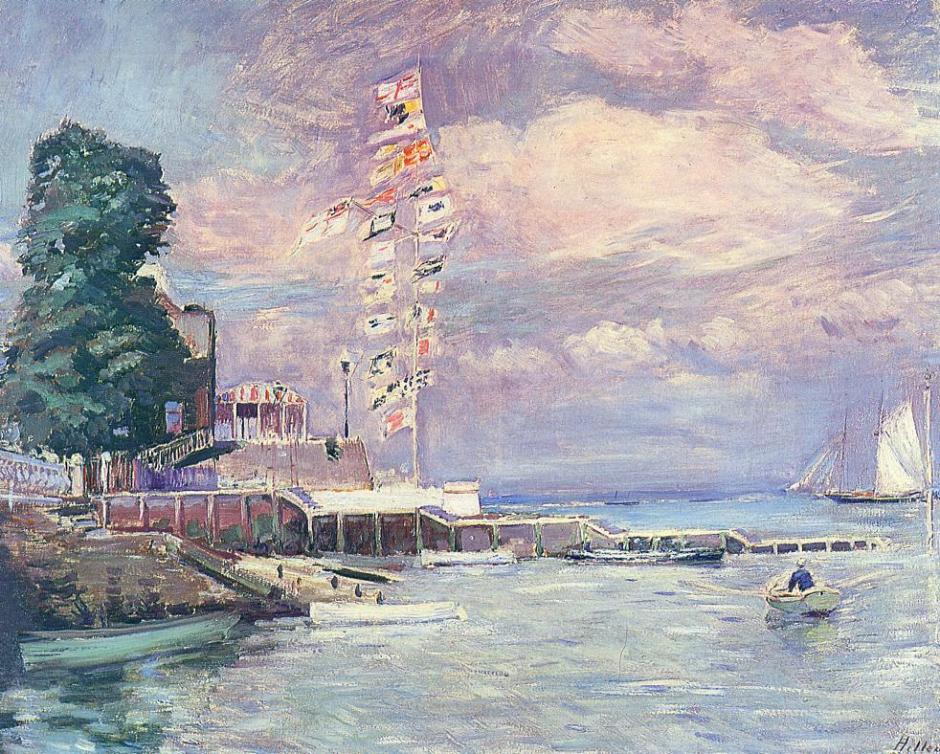Welcome to the second day of our weekend here on the Isle of Wight, which we start in the watercolours of the Pre-Raphaelite Marie Spartali Stillman, whose family owned properties in the south of the island, within walking distance of our house.

She probably painted her undated Farm Scene when she was over here one summer early in her career. It depicts a small thatched cottage on a public road (the signpost at the right), of which there were innumerable examples around the villages of Shanklin and Godshill at the time.

In contrast to the Italianate settings of many of her later paintings, her Wreath of Roses (1880) is very English, and was probably mostly painted during the previous year, when she stayed at her parents’ house in Shanklin for the summer. It’s likely that her two step-daughters, Lisa (then 15) and Bella (12) acted as models. The view through the bottle-glass window has been extensively modified, though: their house has diamond-pane leaded windows, and doesn’t have a moat.
In the nineteenth century, the working port of Cowes in the north of the island flourished as a centre of yachting.

This became a popular theme among British Impressionists. Philip Wilson Steer’s Summer at Cowes from 1888 is a fine early example, and looks west from the ferry port of East Cowes, across the mouth of the River Medina towards the town, by then the centre of English yachting. By the turn of the century, more French artists came to visit, including Paul Helleu, an avid yachtsman.

Regatta (1901) is one of his many yachting scenes, a view looking out from Cowes Harbour on the River Medina over the racing grounds of the Solent. At the left is the clubhouse of the Royal Yacht Squadron, which still organises the racing here.

Le Grand Pavois (c 1901) uses the French term for what in English is called dressed overall, and refers to the naval tradition of displaying a rich variety of flags as a mark of celebration or recognition. As in Regatta above, this appears to be at the Royal Yacht Squadron in Cowes, and would have taken place during the annual Cowes Week racing, perhaps to welcome the monarch. If painted in the summer of 1901, that would have been for the as-yet uncrowned King Edward VII, whose mother, Queen Victoria, had died that January at Osborne House, her palace on the other bank of the River Medina.
The island has hosted a few paintings of significance too.
Before the Reformation, Britain had a rich vernacular tradition of religious wall paintings in most of its churches. The new Church of England reacted against that tradition, and Henry VIII, through Thomas Cromwell, had those paintings destroyed or covered, and dissolved the monasteries.

This example from a parish church just a few miles from where I live is one of only two surviving paintings of a Lily Crucifix, and is thought to date from about 1450. Cromwell’s men ordered that it was removed, but locals covered it with whitewash instead, and it became forgotten until its rediscovery in the middle of the nineteenth century.
In 1845, William Dyce was invited to paint frescos for the Royal Family, for which he travelled to Italy to learn technique. On his return in 1847, he painted this curious composition in Queen Victoria and Prince Albert’s new and luxurious holiday palace of Osborne House, at East Cowes.

Neptune Resigning to Britannia the Empire of the Sea (1847) is an impressive fresco, and remains in pristine condition at the top of the main staircase in the house. Neptune stands astride his three white seahorses (with fish tails!), holding their reins in his right hand, and passing his crown with the left. The crown is just about to be transferred by Mercury (with wings on his cap) to the gold-covered figure of Britannia, who holds a ceremonial silver trident in her right hand.
Neptune is supported by his entourage in the sea, including the statutory brace of nudes and conch-blowers. At the right, Britannia’s entourage is more serious in intent, and includes the lion of England, and figures representing industry, trade, and navigation. The narrative is novel, and a tribute to his monarch, to denote the assumption of power over the seas of the world by Britannia, symbolising the Queen herself. It’s undiluted flattery, of course, and exquisitely executed.
The eminent photographer Julia Margaret Cameron was a pioneer who lived and photographed in Dimbola Lodge in Freshwater. Her house and studio have been turned into a museum, and are well worth a visit when you next come over here.

Cameron’s print of The Parting of Sir Lancelot and Queen Guinevere from 1874 is an example of how she posed friends and acquaintances to re-enact scenes in front of the lens.
Not far from her house is Faringford, the former estate of Alfred, Lord Tennyson, the great British poet.

Hallam Tennyson, 2nd Baron Tennyson (1908) is Briton Rivière’s portrait of the poet’s son, who had retired in 1904 as the second Governor-General of Australia, and was then living at Faringford.
Last and definitely least, I offer one of my own watercolours, painted a few years ago looking north towards Cowes and Southampton Water, from the Downs a couple of fields away from my window.

It has been a pleasure seeing you here, and I hope you’ll return soon.

